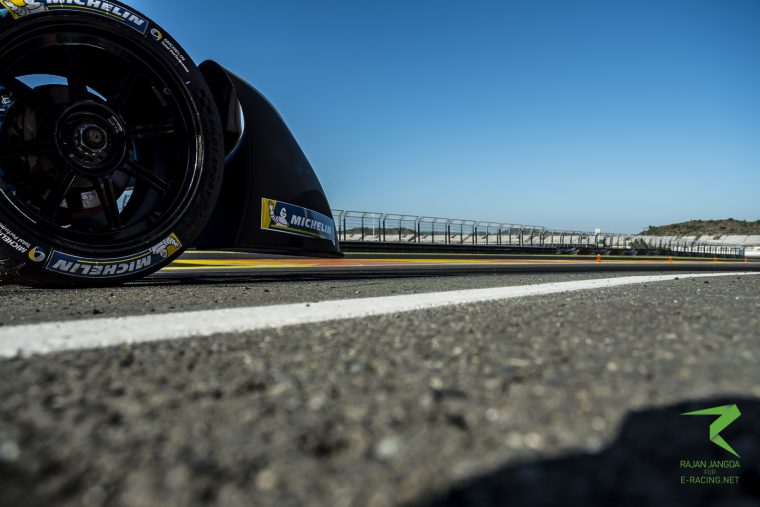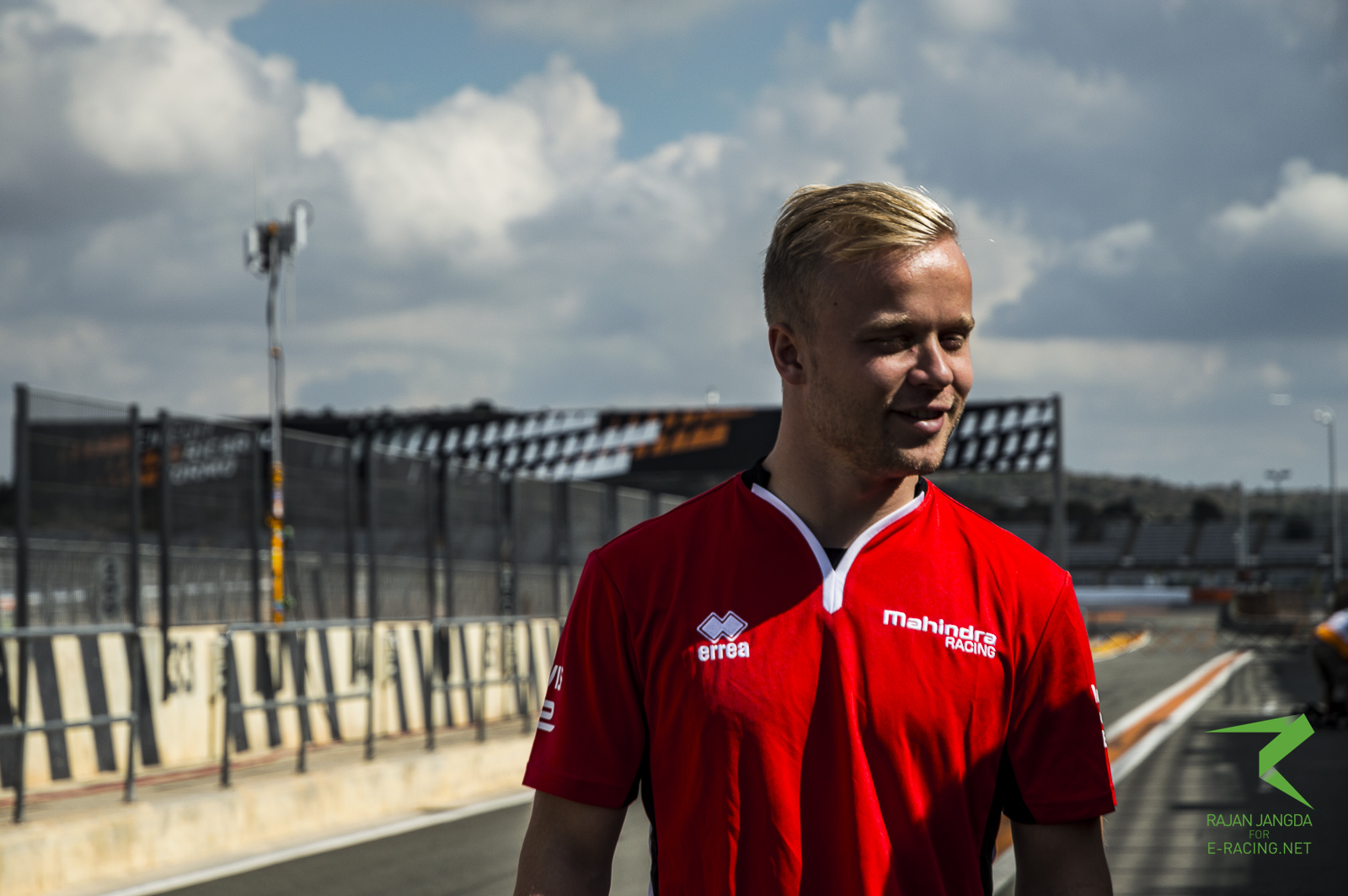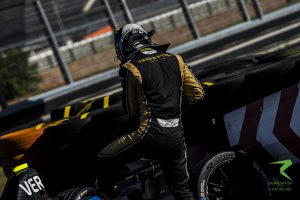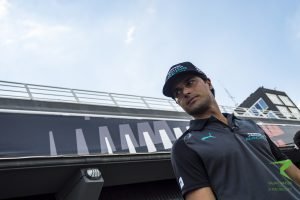Ask the drivers: Why is FE testing so hard?
[vc_row][vc_column][vc_column_text]
Formula E testing this year move from the series’ original home base, Donington Park, to Ricardo Tormo in Valencia. From chicanery to sunshine, the circuit has ended up being one of the main topics of discussion at testing – we asked the drivers how, if it was even possible, FE could fix the testing dilemma.
Ricardo Tormo is another flowing, high-speed circuit – without significant kerbs, as it’s primarily used for bike racing. It’s definitely nothing like a Formula E street circuit, so how are teams meant to get meaningful information about testing from it?
Over the four days of testing, we asked the drivers whether the move had improved anything – and what, if anything, could give a more realistic test.
Firstly, we had to straight-up ask if Ricardo Tormo was better than Donington. Felix Rosenqvist, a driver who always gives good answers about the technicalities of tracks, said “I would say they are equally bad testing circuits for Formula E. It’s a problem at the moment that the circuits that are representative maybe don’t have the infrastructure to host a full Formula E test with power supply and all that.”
Formula E does have significant demands – both the power supply mentioned by Rosenqvist and the need for garage space that some circuits might not have. Indeed, some city centres might not unless they have a convenient park nearby.
Daniel Abt took it a step further by telling us that Valencia was ‘even worse’ than Donington – “To be fair, I think this track here is even worse than Donington and you just have too big corners, you have a different tarmac, you have all sorts of stuff that you don’t have on a street track, you have no kerb riding here.”
Which leads us sort-of-neatly into one of the most signficant bones for contention of the move, which was that special permission would be required to affix kerbs to the grassy edges of the circuit (which has to maintain standards fit for FIA approval for bike racing) even temporarily and Formula E decided not to disrupt the circuit by doing so. So, how to make a flowing, wall-less track more like a screechingly tight, walled city circuit?
Something everyone agreed about was that the false chicanes added to Ricardo Tormo were not the solution. On the first day of testing there was one – built of tyre barriers at the end of the start/finish straight, the idea was that it would allow drivers to steer around a tighter, more representative corner. Theoretically, anyway – in reality it turned into the most major controversy of the test.
Sebastien Buemi was visibly angry at the setup, after Sam Bird crashed into the chicane, immediately phoning control to complain about the ‘really dangerous’ construction – and Sam himself was clearly unhappy, calling the feature “a bit Mickey Mouse.”
The standard of the construction was the main problem for Lucas Di Grassi, “I don’t think that… if you have to… first, the chicane is not supposed to be there, second the way it was done, it’s not the standard that needs to be done or organised.”
Bird agreed – the construction, specifically, of the chicanes was something the drivers viewed as beneath the championship; “I’m not going to stand here and scream and shout about it. Do I think it’s right? No. Are there better solutions? Yes. Have they been implemented? No.”
Tyre walls are never used as close-to-car barriers in Formula E (or most motorsport above a karting pace) and are an extremely far cry from the kerbed tecpro of a Formula E street circuit construction. For a series that travels the world, bringing its own track with it, using an inferior solution at the end of a high-speed straight led to drivers asking why the kerbs from Berlin had not been brought across.
A solution to the chicane – and the speed that drivers were carrying into it, from coming down the straight – was presented on the Tuesday: another chicane. Still constructed of tyre barriers and as tight as the previous one, this one appeared at the top of the start/finish straight, with drivers initially declaring it even worse than the first one.
Talking about the chicanes, Nelson Piquet Jr said “I don’t know how they could have done it worse” but when we caught up with Alexander Sims, he said that the track had responded to initial criticism, when it looked as though a concrete support was jutting too far off the back of the first barrier into the turn and that at least the chicanes were “vaguely realistic”.
”I think they went and tweaked it after comments – I don’t have a massive issue with the chicanes, to be honest. They’re not so lifelike because you don’t have massive tyre barriers in real life, on the FE tracks I’ve seen but it is what it is, it slows us down and it makes there be some corners that are vaguely realistic for Formula E so it’s beneficial in some senses.”
We ran down a pitlane to ask a frustrated Buemi what his view on the second chicane was, after he went to examine it following a James Rossiter’s crash, as he had with Bird’s the previous day. He said simply “I just think these chicanes are wrong.”
(Rossiter himself said the cause of the crash was ”a small problem in the braking area so suddenly the rears locked” not an issue with the chicane)
So, probably no chicanes on any of the drivers’ fantasy list. Modifying an existing circuit might be an option – but it would require bringing Formula E gear, which almost defeats the point of using a pre-built facility.
On the other hand, 90% of Formula E teams get a chance to test their cars from January-September, as part of 14 days of manufacturer powertrain testing. They can do this wherever they want (under some scrutiny) and derive most of their data for the season from it.
We asked Felix Rosenqvist whether the move had been effective for testing and he dismissed it as a relevant – “I would say they [Donington and Ricardo Tormo] are equally bad testing circuits for Formula E. It’s a problem at the moment that the circuits that are representative maybe don’t have the infrastructure to host a full Formula E test with power supply and all that. So it’s a bit of a… end of the day it’s the same for everyone but it feels a bit stupid to go round these kind of circuits.”
The thing is, for 10% of teams it’s not the same. The only client team on the grid, Techeetah, don’t get the 14 manufacturer testing days – and this is their only chance to run the cars or drivers before the first ePrix of the year; so FE rookie Andre Lotterer has only ever run on a track with no kerb-riding, a staple of the Formula E style. Lotterer is surely experienced enough to get around it but it begs the question of why testing on a track unlike Formula E’s is done.
This year, the planned Roborace day of testing, on the Wednesday, didn’t happen – because the track was meaningless for their testing, the lack of walls unrealistic for what the AIs needed to learn or lidar sensors could detect. Ironically, Roborace stayed home and tested on their purpose-built imitation Formula E circuit. So at least someone was, maybe.
Some elements of Formula E cars’ setup become parc ferme shortly after pre-season testing, so if teams cannot get them right by this point, they might be hampered all year. So why test at unrepresentative circuits?
Piquet Jr said it was a matter of practicality- “We have been testing a lot in Calafat, there’s like four or five teams that test at this place in Spain but I don’t know if Formula E would like to host the pre-event get-together there because it doesn’t look as nice as this.”
“I don’t think Formula E wants to bring media and sponsors and partners and broadcast and all this crap to a small track where there’s maybe one bathroom, stuff like that. So this is more of a get-together than anything else. You know, testing for us… we’ve learned much more going to Calafat and other smaller, tighter tracks.”
While Calafat and other small tracks can support one team testing for a day, ten teams testing for three days is an entirely different issue – the power demands alone are a challenge but so is space and things as apparently trivial as internet connection. Anyone who’s ever been in a media centre where the bandwidth is struggling will be nodding sagely to that one but teams have far greater data demands, even if the session was closed to the rest of us.
Maro Engel echoed the infrastructural concerns – ”it’s definitely not representative for a Formula E track. The challenge is always finding tracks that are representative because it’s not like there are that many and you can’t just block off a city centre and say “we’d like to test for a few days” so it’s not an easy task, for sure but maybe for the future we can improve the situation.”
Maro also suggested to us that the Berlin track at Tempelhof might be an option – <em<”I don’t know if it’s an option even to say a place like Tempelhof, where we go racing, we could potentially maybe have that for a test – I don’t know, it’s just an idea.”
Tempelhof has obvious advantages – the existing buildings of the former airport mean there’s an on-site, significant power supply and a lot of infrastructure, as well as a pre-existing Formula E circuit. It’s off the roads and fairly well hidden, so closed testing can take place – in fact, Audi (then Abt) ran their Season 4 car there earlier this year.
Daniel Abt – who drove the Audi there – called the Berlin track “not a bad idea” for testing and Felix Rosenqvist suggested it could work even beyond the pre-season test – ”I mean, that would be great. I think also in-season testing, on the actual race tracks like in Berlin you could have the opportunity to test for two days after the race, something like that is something I think – I think they did it in Season 2, in Punta Del Esta and for me it’s something that would be nice to continue here. But yeah, that’s a good idea.”
However, putting together the Tempelhof track still requires the venue to be available, permission to be granted by the Berlin authorities and Formula E to essentially recreate an ePrix, in logistics terms. As pointed out by Piquet Jr, it’s not as practical as it sounds – ”I think it could. Problem is building that thing would be a pain in the ass for Formula E, they would have to spend money and everything – if they can go to a facility that is ready why would they want to build a whole track just for a couple of days of testing? I don’t think it’s worth it.
“And let’s be honest, Tempelhof is not the closest track to a street track – yeah it was a bit twisty here and there, we used the real kerbs that we use but unless we go to an abandoned city somewhere and build a fake race track or something, that’s the only way I see it. Or a very big go-kart track perhaps, one day.”
In theory, one of the ideas in moving was to get warmer – the UK in October is colder than any track Formula E race on. Moving to Valencia, where temperatures were a more representative 24-28C, unlike the UK’s 9-12C, is good for testing tyres and battery temperatures, something it’s extremely important to control – even a team as experienced as Renault e.Dams had a battery fire on Nico Prost’s car at the end of Race 1 in Montreal.
Daniel Abt said that hadn’t necessarily been a factor, at least for drivers: “Ah… that’s something you learn a bit here… or can learn, if it’s new to you but for us it’s not that relevant. It actually harms you in running also, you need to cool more so I think it’s not really an important point.”
On the other hand, at least it wasn’t raining. Nearly all the drivers mentioned the improved weather and Maro Engel pointed out the weather consistency was also better, with sustained conditions that meant you could get a better feel for setup changes without having to factor in other variables.
Maybe the solution is that pre-season testing has to be the showcase event – when the teams all come together in situ and everyone is past the point of developing their own car to wanting to nose at other people’s. But that seems extremely unfair on client teams, for whom this is the only pre-season running they’ll get.
With only one on customer team on the grid and manufacturers queueing up to get into Formula E, maybe it’s not a real problem per se but maybe the best solution is to let Techeetah and any other teams that go down a customer route have at least one day pre-pre-season testing, somewhere more representative.
On E-Racing.net’s part, awaiting the long winter season of freezing circuit experiences, our experience of the switch was that we appreciated being warm – and back in the staticky embrace of Formula E. Something echoed by Felix Rosenqvist-
“I’m not complaining, it’s good weather – it’s just fun to be around with all the teams again, it feels a bit like a race weekend even though it’s not. But yeah, in the future maybe it would be a good thing to start looking at a special Formula E circuit for these things, as the championship progresses.”
[/vc_column_text][/vc_column][/vc_row][vc_row][vc_column][vc_column_text]
Image courtesy of Rajan Jangda
[/vc_column_text][/vc_column][/vc_row]








 No part of this website or any of its contents may be reproduced, copied, modified, adapted, used or distributed without the prior written consent of the author. e-racing.net is not responsible for the content of external sites or links.
No part of this website or any of its contents may be reproduced, copied, modified, adapted, used or distributed without the prior written consent of the author. e-racing.net is not responsible for the content of external sites or links.